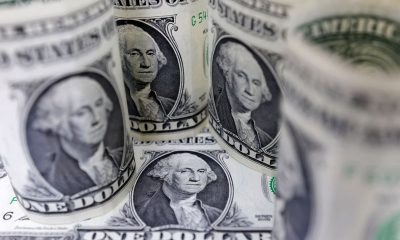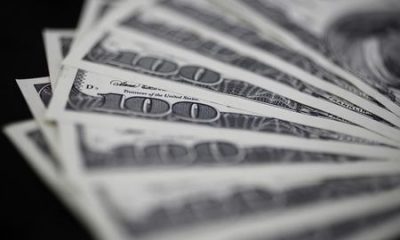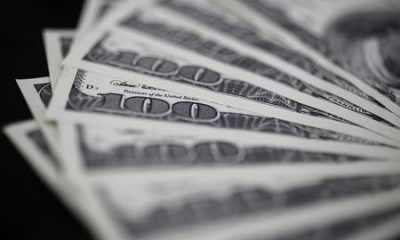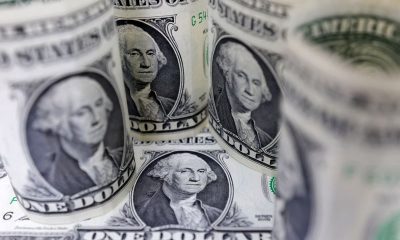Economy
Frazzled U.S. stock investors eye frothy Treasury market as Fed looms

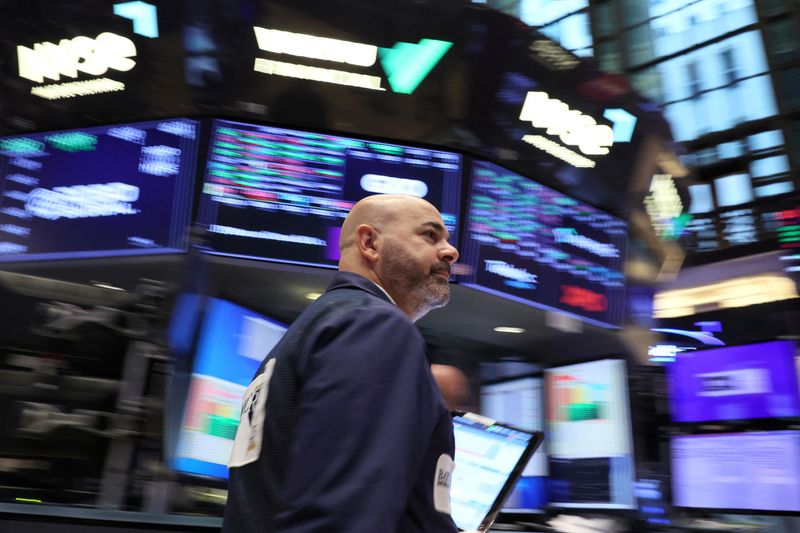
© Reuters. A trader works on the floor at the New York Stock Exchange (NYSE) in New York City, U.S., October 27, 2023. REUTERS/Brendan McDermid
By David Randall
NEW YORK (Reuters) – Financial markets are bracing for what could be a momentous week, with a Federal Reserve meeting, U.S. employment data and earnings from technology heavyweight Apple Inc (NASDAQ:) possibly setting the course for stocks and bonds the rest of the year.
October has lived up to its reputation for volatility, as a surge in Treasury yields and geopolitical uncertainty pressured stocks. The is down 3.5% for the month, adding to losses that have left it over 10% off its late-July high.
Whether the ride remains rough for the rest of 2023 may depend in large part on the bond market. The Fed’s ‘higher for longer’ stance on interest rates and rising U.S. fiscal worries pushed the benchmark – which moves inversely to prices – to 5% earlier this month, the highest since 2007. Higher Treasury yields are seen as a headwind to stocks, in part because they compete with equities for buyers.
Investors worry that yields could rise further if the Fed reinforces its hawkish message at the central bank’s Nov. 1 monetary policy meeting. Strong U.S. employment data next Friday could also be a catalyst for yields to rise if it bolsters the case for keeping rates elevated to cool the economy and prevent inflation from rebounding.
“Stocks will start to recover when the market believes that bond yields have peaked,” said Sam Stovall, chief investment strategist at CFRA Research.
Overall, futures markets are pricing in a near-certainty that the Fed does not raise rates in November, and a nearly 80% chance that the central bank holds rates steady in December, according to CME’s FedWatch Tool. Still, policymakers have projected they will keep the key policy rate at current levels through most of 2024, longer than markets had previously anticipated.
Investors are playing a “waiting game of how much does each economic data point need to increase to put another rate hike back on the table,” said Alex McGrath, chief investment officer for NorthEnd Private Wealth.
With U.S. Gross Domestic Product growth at a sizzling 4.9% in the third quarter, signs that the labor market remains too hot, or the Fed sees the need for further tightening to control inflation, could fuel further volatility.
“It feels like we are at a crossroads whether or not the strong growth we’ve seen over the summer months will continue over the fourth quarter,” and keep worries over inflation and restrictive monetary policy bubbling, said Charlie Ripley, senior investment strategist for Allianz (ETR:) Investment Management.
Adding to the bond market’s concerns, the Treasury is expected to announce its upcoming auction sizes later this week. Worries about a growing federal deficit and increased supply have helped push yields higher.
Investors are also awaiting Apple’s results on Thursday, during an earnings season with disappointments from some growth and technology giants, including Tesla (NASDAQ:) and Google (NASDAQ:). The tech-heavy is down 11% from its high, though still up nearly 30% on the year.
Some investors believe the worst of the selling may be over.
A stock market rebound would follow seasonal trends, said Stovall, of CFRA Research. Since 1945, the S&P 500 has advanced by an average of 1.5% in November, making it the year’s third-best performing month, he said.
More broadly, some believe the stock market’s trading patterns this year point to a rebound in the fourth quarter.
In the 14 instances when the S&P 500 has gained at least 10% through July and then declined in August, as it did this year, the index has increased every time over the last four months of the year, according to Ned Davis Research. The average gain in those instances has been 10%.
Stocks appear “oversold” according to technical indicators and could rally if economic data comes in as expected, said Randy Frederick, managing director of trading and derivatives for the Schwab Center for Financial Research.
“The stock market is poised for a late Q4 rally.”
Economy
Russian central bank says it needs months to make sure CPI falling before rate cuts -RBC


© Reuters. Russian Central Bank Governor Elvira Nabiullina attends a news conference in Moscow, Russia June 14, 2019. REUTERS/Shamil Zhumatov/File Photo
MOSCOW (Reuters) – Russia’s central bank will need two to three months to make sure that inflation is steadily declining before taking any decision on interest rate cuts, the bank’s governor Elvira Nabiullina told RBC media on Sunday.
The central bank raised its key interest rate by 100 basis points to 16% earlier in December, hiking for the fifth consecutive meeting in response to stubborn inflation, and suggested that its tightening cycle was nearly over.
Nabiullina said it was not yet clear when exactly the regulator would start cutting rates, however.
“We really need to make sure that inflation is steadily decreasing, that these are not one-off factors that can affect the rate of price growth in a particular month,” she said.
Nabiullina said the bank was taking into account a wide range of indicators but primarily those that “characterize the stability of inflation”.
“This will take two or three months or more – it depends on how much the wide range of indicators that characterize sustainable inflation declines,” she said.
The bank will next convene to set its benchmark rate on Feb. 16.
The governor also said the bank should have started monetary policy tightening earlier than in July, when it embarked on the rate-hiking cycle.
Economy
China identifies second set of projects in $140 billion spending plan


© Reuters. FILE PHOTO: Workers walk past an under-construction area with completed office towers in the background, in Shenzhen’s Qianhai new district, Guangdong province, China August 25, 2023. REUTERS/David Kirton/File Photo
SHANGHAI (Reuters) – China’s top planning body said on Saturday it had identified a second batch of public investment projects, including flood control and disaster relief programmes, under a bond issuance and investment plan announced in October to boost the economy.
With the latest tranche, China has now earmarked more than 800 billion yuan of its 1 trillion yuan ($140 billion) in additional government bond issuance in the fourth quarter, as it focuses on fiscal steps to shore up the flagging economy.
The National Development and Reform Commission (NDRC) said in a statement on Saturday it had identified 9,600 projects with planned investment of more than 560 billion yuan.
China’s economy, the world’s second largest, is struggling to regain its footing post-COVID-19 as policymakers grapple with tepid consumer demand, weak exports, falling foreign investment and a deepening real estate crisis.
The 1 trillion yuan in additional bond issuance will widen China’s 2023 budget deficit ratio to around 3.8 percent from 3 percent, the state-run Xinhua news agency has said.
“Construction of the projects will improve China’s flood control system, emergency response mechanism and disaster relief capabilities, and better protect people’s lives and property, so it is very significant,” the NDRC said.
The agency said it will coordinate with other government bodies to make sure that funds are allocated speedily for investment and that high standards of quality are maintained in project construction.
($1 = 7.1315 renminbi)
Economy
Russian central bank says it needs months to make sure CPI falling before rate cuts -RBC


© Reuters. Russian Central Bank Governor Elvira Nabiullina attends a news conference in Moscow, Russia June 14, 2019. REUTERS/Shamil Zhumatov/File Photo
MOSCOW (Reuters) – Russia’s central bank will need two to three months to make sure that inflation is steadily declining before taking any decision on interest rate cuts, the bank’s governor Elvira Nabiullina told RBC media on Sunday.
The central bank raised its key interest rate by 100 basis points to 16% earlier in December, hiking for the fifth consecutive meeting in response to stubborn inflation, and suggested that its tightening cycle was nearly over.
Nabiullina said it was not yet clear when exactly the regulator would start cutting rates, however.
“We really need to make sure that inflation is steadily decreasing, that these are not one-off factors that can affect the rate of price growth in a particular month,” she said.
Nabiullina said the bank was taking into account a wide range of indicators but primarily those that “characterize the stability of inflation”.
“This will take two or three months or more – it depends on how much the wide range of indicators that characterize sustainable inflation declines,” she said.
The bank will next convene to set its benchmark rate on Feb. 16.
The governor also said the bank should have started monetary policy tightening earlier than in July, when it embarked on the rate-hiking cycle.

 Forex2 years ago
Forex2 years agoForex Today: the dollar is gaining strength amid gloomy sentiment at the start of the Fed’s week

 Forex2 years ago
Forex2 years agoHow is the Australian dollar doing today?

 Forex1 year ago
Forex1 year agoUnbiased review of Pocket Option broker

 Forex2 years ago
Forex2 years agoDollar to pound sterling exchange rate today: Pound plummeted to its lowest since 1985

 Cryptocurrency2 years ago
Cryptocurrency2 years agoWhat happened in the crypto market – current events today

 World2 years ago
World2 years agoWhy are modern video games an art form?

 Stock Markets2 years ago
Stock Markets2 years agoMorgan Stanley: bear market rally to continue

 Economy2 years ago
Economy2 years agoCrude oil tankers double in price due to EU anti-Russian sanctions

